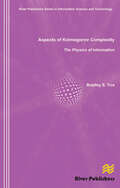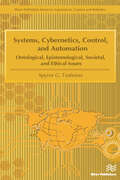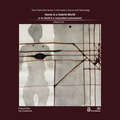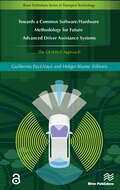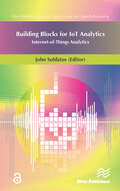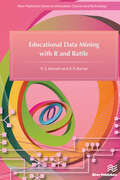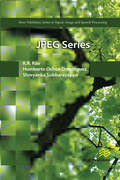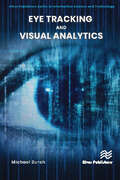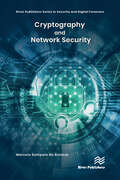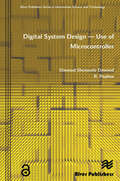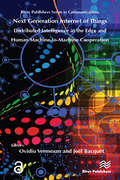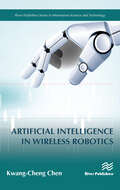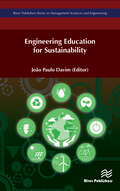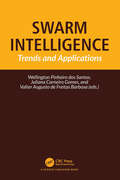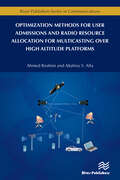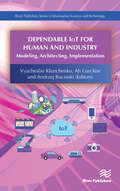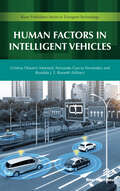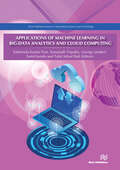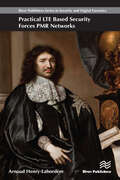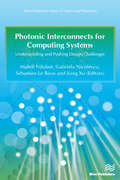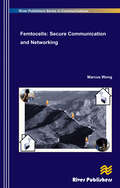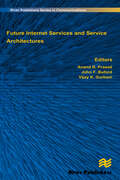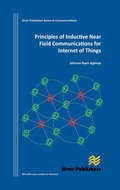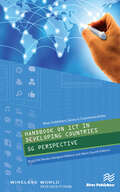- Table View
- List View
Aspects of Kolmogorov Complexity the Physics of Information (River Publishers Series In Information Science And Technology Ser.)
by Bradley S. TiceThe research presented in Aspects of Kolmogorov Complexity addresses the fundamental standard of defining randomness as measured by a Martin-Lof level of randomness as found in random sequential binary strings. A classical study of statistics that addresses both a fundamental standard of statistics as well as an applied measure for statistical communication theory. The research points to compression levels in a random state that are greater than is found in current literature. A historical overview of the field of Kolmogorov Complexity and Algorithmic Information Theory, a subfield of Information Theory, is given as well as examples using a radix 3, radix 4, and radix 5 base numbers for both random and non-random sequential strings. The text also examines monochromatic and chromatic symbols and both theoretical and applied aspects of data compression as they relate to the transmission and storage of information. The appendix contains papers on the subject given at conferences and the references are current.ContentsTechnical topics addressed in Aspects of Kolmogorov Complexity include:• Statistical Communication Theory• Algorithmic Information Theory• Kolmogorov Complexity• Martin-Lof Randomness• Compression, Transmission and Storage of Information
Systems, Cybernetics, Control, and Automation
by Spyros G. TzafestasSystems, cybernetics, control, and automation (SCCA)are four interrelated and overlapping scientific and technological fields that have contributed substantially to the development, growth, and progress of human society. A large number of models, methods, and tools were developed that assure high efficiency of SCCA applied to practical situations. The real-life applications of SCCA encompass a wide range of man-made or biological systems, including transportations, power generation, chemical industry, robotics, manufacturing, cybernetics organisms (cyborgs), aviation, economic systems, enterprise, systems, medical/health systems, environmental applications, and so on. The SCCA fields exhibit strong influences on society and rise, during their use and application, many ethical concerns and dilemmas. This book provides a consolidated and concise overview of SCCA, in a single volume for the first time, focusing on ontological, epistemological, social impact, ethical, and general philosophical issues. It is appropriate for use in engineering courses as a convenient tutorial source providing fundamental conceptual and educational material on these issues, or for independent reading by students and scientists.Included in the book is:• Background material on philosophy and systems theory• Major ontological, epistemological, societal and ethical/philosophical aspects of the four fields that are considered in the book• Over 400 references and a list of 130 additional books in the relevant fields • Over 100 colored photos and 70 line figures that illustrate the text
Home in A Hybrid World: or To Dwell in A Networked Environment (River Publishers Series In Information Science And Technology Ser.)
by Martin PotWhilst our outside world is modifying into a more complex and hybrid networked world, our most intimate dwelling, our home, is at risk of falling behind as for many it seems to have remained the same as it has been for many decades. This book explores what it means to have a home in such a networked world. It describes what architecture can, or perhaps should, contribute to enable a more participatory role for inhabitants. This forward-thinking book will try to answer the question - What is the role and position of technology in our most intimate locations both now and what could it be like in the future?
Towards a Common Software/Hardware Methodology for Future Advanced Driver Assistance Systems: The Deserve Approach (River Publishers Series In Transport Technology Is A Series Of Comprehensive Academic And Professional Books Which Focus On Theory And Applications In The Various Disciplines Within Transport Technology, Namely Automotive And Aerospace. The Series Will Serve As A Multi-disciplinary Resource Linking Transport Technology With Society. The Book Series Fulfills The Rapidly Growing Worldwide Interest I)
by Guillermo Payá-Vayá Holger BlumeThe European research project DESERVE (DEvelopment platform for Safe and Efficient dRiVE, 2012-2015) had the aim of designing and developing a platform tool to cope with the continuously increasing complexity and the simultaneous need to reduce cost for future embedded Advanced Driver Assistance Systems (ADAS). For this purpose, the DESERVE platform profits from cross-domain software reuse, standardization of automotive software component interfaces, and easy but safety-compliant integration of heterogeneous modules. This enables the development of a new generation of ADAS applications, which challengingly combine different functions, sensors, actuators, hardware platforms, and Human Machine Interfaces (HMI). This book presents the different results of the DESERVE project concerning the ADAS development platform, test case functions, and validation and evaluation of different approaches. The reader is invited to substantiate the content of this book with the deliverables published during the DESERVE project. Technical topics discussed in this book include:Modern ADAS development platforms;Design space exploration;Driving modelling;Video-based and Radar-based ADAS functions;HMI for ADAS;Vehicle-hardware-in-the-loop validation systems
Building Blocks for IoT Analytics Internet-of-Things Analytics
by John SoldatosInternet-of-Things (IoT) Analytics are an integral element of most IoT applications, as it provides the means to extract knowledge, drive actuation services and optimize decision making. IoT analytics will be a major contributor to IoT business value in the coming years, as it will enable organizations to process and fully leverage large amounts of IoT data, which are nowadays largely underutilized. The Building Blocks of IoT Analytics is devoted to the presentation the main technology building blocks that comprise advanced IoT analytics systems. It introduces IoT analytics as a special case of BigData analytics and accordingly presents leading edge technologies that can be deployed in order to successfully confront the main challenges of IoT analytics applications. Special emphasis is paid in the presentation of technologies for IoT streaming and semantic interoperability across diverse IoT streams. Furthermore, the role of cloud computing and BigData technologies in IoT analytics are presented, along with practical tools for implementing, deploying and operating non-trivial IoT applications. Along with the main building blocks of IoT analytics systems and applications, the book presents a series of practical applications, which illustrate the use of these technologies in the scope of pragmatic applications. Technical topics discussed in the book include: Cloud Computing and BigData for IoT analyticsSearching the Internet of ThingsDevelopment Tools for IoT Analytics ApplicationsIoT Analytics-as-a-ServiceSemantic Modelling and Reasoning for IoT AnalyticsIoT analytics for Smart BuildingsIoT analytics for Smart CitiesOperationalization of IoT analyticsEthical aspects of IoT analyticsThis book contains both research oriented and applied articles on IoT analytics, including several articles reflecting work undertaken in the scope of recent European Commission funded projects in the scope of the FP7 and H2020 programmes. These articles present results of these projects on IoT analytics platforms and applications. Even though several articles have been contributed by different authors, they are structured in a well thought order that facilitates the reader either to follow the evolution of the book or to focus on specific topics depending on his/her background and interest in IoT and IoT analytics technologies. The compilation of these articles in this edited volume has been largely motivated by the close collaboration of the co-authors in the scope of working groups and IoT events organized by the Internet-of-Things Research Cluster (IERC), which is currently a part of EU's Alliance for Internet of Things Innovation (AIOTI).
Educational Data Mining with R and Rattle
by R.S. Kamath R.K. KamatEducational Data Mining (EDM) is one of the emerging fields in the pedagogy and andragogy paradigm, it concerns the techniques which research data coming from the educational domain. EDM is a promising discipline which has an imperative impact on predicting students' academic performance. It includes the transformation of existing, and the innovation of new approaches derived from multidisciplinary spheres of influence such as statistics, machine learning, psychometrics, scientific computing etc.An archetype that is covered in this book is that of learning by example. The intention is that reader will easily be able to replicate the given examples and then adapt them to suit their own needs of teaching-learning. The content of the book is based on the research work undertaken by the authors on the theme "Mining of Educational Data for the Analysis and Prediction of Students' Academic Performance". The basic know-how presented in this book can be treated as guide for educational data mining implementation using R and Rattle open source data mining tools. .Technical topics discussed in the book include:• Emerging Research Directions in Educational Data Mining• Design Aspects and Developmental Framework of the System• Model Development - Building Classifiers• Educational Data Analysis: Clustering Approach
JPEG Series
by K.R. Rao Humberto Ochoa DomínguezWhile the JPEG image standard was developed more than 25 years ago, it is still dominant in terms of image formation, manipulation and transmission over the internet and other media. As technology advances, new demands have arisen for the efficient transmission and storage of images causing other formats to emerge. Over the years, several extensions such as, JPEGLS, JPEG2K, JPEGXT, JPEGXR, JPEGXS and JPEG Pleno, have been added, constructing a series of standards for the compression and transmission of images. This book is the first to bring together most of the series of JPEG standards in a book.This book covers the descriptions of the JPEG standards and gives the reader an overview of the latest advances in the standards of the Joint Photographic Experts Group.Topics discussed include: • JEPG;• JPEG XR;• JPEG XT;• JPEG 2000;• JPEG XS;• JPEG Pleno;• JPEG AIC;• JPEG LS;• JPEG XL;• JPSearch;• JPEG Systems;• JBIG
Eye Tracking and Visual Analytics
by Michael BurchVisualization and visual analytics are powerful concepts for exploring data from various application domains. The endless number of possible parameters and the many ways to combine visual variables as well as algorithms and interaction techniques create lots of possibilities for building such techniques and tools.The major goal of those tools is to include the human users with their tasks at hand, their hypotheses, and research questions to provide ways to find solutions to their problems or at least to hint them in a certain direction to come closer to a problem solution. However, due to the sheer number of design variations, it is unclear which technique is suitable for those tasks at hand, requiring some kind of user evaluation to figure out how the human users perform while solving their tasks.The technology of eye tracking has existed for a long time; however, it has only recently been applied to visualization and visual analytics as a means to provide insights to the users’ visual attention behavior. This generates another kind of dataset that has a spatio-temporal nature and hence demands for advanced data science and visual analytics concepts to find insights into the recorded eye movement data, either as a post process or even in real-time.This book describes aspects from the interdisciplinary field of visual analytics, but also discusses more general approaches from the field of visualization as well as algorithms and data handling. A major part of the book covers research on those aspects under the light and perspective of eye tracking, building synergy effects between both fields – eye tracking and visual analytics – in both directions, i.e. eye tracking applied to visual analytics and visual analytics applied to eye tracking data. Technical topics discussed in the book include: • Visualization; • Visual Analytics; • User Evaluation; • Eye Tracking; • Eye Tracking Data Analytics;Eye Tracking and Visual Analytics includes more than 500 references from the fields of visualization, visual analytics, user evaluation, eye tracking, and data science, all fields which have their roots in computer science.Eye Tracking and Visual Analytics is written for researchers in both academia and industry, particularly newcomers starting their PhD, but also for PostDocs and professionals with a longer research history in one or more of the covered research fields. Moreover, it can be used to get an overview about one or more of the involved fields and to understand the interface and synergy effects between all of those fields. The book might even be used for teaching lectures in the fields of information visualization, visual analytics, and/or eye tracking.
Cryptography and Network Security
by Marcelo Sampaio de AlencarStarting with the historical evolution of computer and communications networks and their security, the book then arrives at the main definitions of cryptography and network security. Next, the basics of information theory, how to measure information, the information associated with a certain source are also discussed. Source codes are presented, along with the concepts of information transmission, joint information, conditional entropy, mutual information and channel capacity. Computer networks are discussed, including the main protocols and network architectures, and the important TCP/IP protocol. Network security, a topic intrinsically connected to computer networks and the Internet, is presented, along with information about basic hacker attacks, alternatives to prevent attacks, data protection and secure protocols. The information theoretical aspects of cryptography are described including the hash function. An appendix includes a review of probability theory. Illustrations and graphics will help the reader understand the theory.
Digital System Design - Use of Microcontroller: Use Of Microcontroller (River Publishers Series In Signal, Image And Speech Processing Ser.)
by Shenouda Dawoud R. PeplowEmbedded systems are today, widely deployed in just about every piece of machinery from toasters to spacecraft. Embedded system designers face many challenges. They are asked to produce increasingly complex systems using the latest technologies, but these technologies are changing faster than ever. They are asked to produce better quality designs with a shorter time-to-market. They are asked to implement increasingly complex functionality but more importantly to satisfy numerous other constraints. To achieve the current goals of design, the designer must be aware with such design constraints and more importantly, the factors that have a direct effect on them.One of the challenges facing embedded system designers is the selection of the optimum processor for the application in hand; single-purpose, general-purpose or application specific. Microcontrollers are one member of the family of the application specific processors.The book concentrates on the use of microcontroller as the embedded system?s processor, and how to use it in many embedded system applications. The book covers both the hardware and software aspects needed to design using microcontroller.The book is ideal for undergraduate students and also the engineers that are working in the field of digital system design.Contents• Preface;• Process design metrics;• A systems approach to digital system design;• Introduction to microcontrollers and microprocessors;• Instructions and Instruction sets;• Machine language and assembly language;• System memory; Timers, counters and watchdog timer;• Interfacing to local devices / peripherals;• Analogue data and the analogue I/O subsystem;• Multiprocessor communications;• Serial Communications and Network-based interfaces.
Next Generation Internet of Things – Distributed Intelligence at the Edge and Human-Machine Interactions
by Ovidiu Vermesan Joël BacquetThis book provides an overview of the next generation Internet of Things (IoT), ranging from research, innovation, development priorities, to enabling technologies in a global context. It is intended as a standalone in a series covering the activities of the Internet of Things European Research Cluster (IERC), including research, technological innovation, validation, and deployment.The following chapters build on the ideas put forward by the European Research Cluster, the IoT European Platform Initiative (IoT–EPI), the IoT European Large-Scale Pilots Programme and the IoT European Security and Privacy Projects, presenting global views and state-of-the-art results regarding the next generation of IoT research, innovation, development, and deployment.The IoT and Industrial Internet of Things (IIoT) are evolving towards the next generation of Tactile IoT/IIoT, bringing together hyperconnectivity (5G and beyond), edge computing, Distributed Ledger Technologies (DLTs), virtual/ andaugmented reality (VR/AR), and artificial intelligence (AI) transformation.Following the wider adoption of consumer IoT, the next generation of IoT/IIoT innovation for business is driven by industries, addressing interoperability issues and providing new end-to-end security solutions to face continuous treats.The advances of AI technology in vision, speech recognition, natural language processing and dialog are enabling the development of end-to-end intelligent systems encapsulating multiple technologies, delivering services in real-time using limited resources. These developments are focusing on designing and delivering embedded and hierarchical AI solutions in IoT/IIoT, edge computing, using distributed architectures, DLTs platforms and distributed end-to-end security, which provide real-time decisions using less data and computational resources, while accessing each type of resource in a way that enhances the accuracy and performance of models in the various IoT/IIoT applications.The convergence and combination of IoT, AI and other related technologies to derive insights, decisions and revenue from sensor data provide new business models and sources of monetization. Meanwhile, scalable, IoT-enabled applications have become part of larger business objectives, enabling digital transformation with a focus on new services and applications.Serving the next generation of Tactile IoT/IIoT real-time use cases over 5G and Network Slicing technology is essential for consumer and industrial applications and support reducing operational costs, increasing efficiency and leveraging additional capabilities for real-time autonomous systems.New IoT distributed architectures, combined with system-level architectures for edge/fog computing, are evolving IoT platforms, including AI and DLTs, with embedded intelligence into the hyperconnectivity infrastructure.The next generation of IoT/IIoT technologies are highly transformational, enabling innovation at scale, and autonomous decision-making in various application domains such as healthcare, smart homes, smart buildings, smart cities, energy, agriculture, transportation and autonomous vehicles, the military, logistics and supply chain, retail and wholesale, manufacturing, mining and oil and gas.
Artificial Intelligence in Wireless Robotics (River Publishers Series In Information Science And Technology Ser.)
by Kwang-Cheng ChenRobots, autonomous vehicles, unmanned aerial vehicles, and smart factory, will significantly change human living style in digital society. Artificial Intelligence in Wireless Robotics introduces how wireless communications and networking technology enhances facilitation of artificial intelligence in robotics, which bridges basic multi-disciplinary knowledge among artificial intelligence, wireless communications, computing, and control in robotics. A unique aspect of the book is to introduce applying communication and signal processing techniques to enhance traditional artificial intelligence in robotics and multi-agent systems.The technical contents of this book include fundamental knowledge in robotics, cyber-physical systems, artificial intelligence, statistical decision and Markov decision process, reinforcement learning, state estimation, localization, computer vision and multi-modal data fusion, robot planning, multi-agent systems, networked multi-agent systems, security and robustness of networked robots, and ultra-reliable and low-latency machine-to-machine networking. Examples and exercises are provided for easy and effective comprehension.Engineers wishing to extend knowledge in the robotics, AI, and wireless communications, would be benefited from this book. In the meantime, the book is ready as a textbook for senior undergraduate students or first-year graduate students in electrical engineering, computer engineering, computer science, and general engineering students. The readers of this book shall have basic knowledge in undergraduate probability and linear algebra, and basic programming capability, in order to enjoy deep reading.
Engineering Education for Sustainability
by João Paulo DavimUnderstood to be a key issue in modern society, sustainability is characterized by its three essential pillars, namely: the environment, society and the economy. Education plays an important role in how people understand and accept sustainability. The integration of sustainability in engineering education is a relatively new phenomenon, and presenting information about engineering education for sustainability is of great interest to improve communication between professors, researchers and students at universities, institutes and research laboratories.Topics discussed in the book include: Experiences from 5 years of educating sustainability to computer science students Review of decision support methods in green and sustainable supply chains Analyzing the drivers of engineering education for sustainability using the MCDM approach Visualization technologies in construction education: a comprehensive review of recent advances A legal framework and compliance with construction safety laws and regulations
Swarm Intelligence: Trends and Applications
by Juliana Carneiro Gomes Wellington Pinheiro dos Santos Valter Augusto de Freitas BarbosaThis book presents the fundamentals of swarm intelligence, from classic algorithms to emerging techniques. It presents comprehensive theoretical foundations and examples using the main Computational Intelligence methods in programming languages such as Python, Java and MATLAB®. Real-world applications are also presented in areas as diverse as Medicine, Biology and industrial applications. The book is organized into two parts. The first part provides an introduction to swarming algorithms and hybrid techniques. In the second part, real world applications of swarm intelligence are presented to illustrate how swarm algorithms can be used in applications of optimization and pattern recognition, reviewing the principal methods and methodologies in swarm intelligence.
Optimization Methods for User Admissions and Radio Resource Allocation for Multicasting over High Altitude Platforms
by Ahmed Ibrahim Attahiru AlfaThis book focuses on the issue of optimizing radio resource allocation (RRA) and user admission control (AC) for multiple multicasting sessions on a single high altitude platform (HAP) with multiple antennas on-board. HAPs are quasi-stationary aerial platforms that carry a wireless communications payload to provide wireless communications and broadband services. They are meant to be located in the stratosphere layer of the atmosphere at altitudes in the range 17-22 km and have the ability to fly on demand to temporarily or permanently serve regions with unavailable telecommunications infrastructure. An important requirement that the book focusses on is the development of an efficient and effective method for resource allocation and user admissions for HAPs, especially when it comes to multicasting. Power, frequency, space (antennas selection) and time (scheduling) are the resources considered in the problem over an orthogonal frequency division multiple access (OFDMA) HAP system.Due to the strong dependence of the total number of users that could join different multicast groups, on the possible ways we may allocate resources to these groups, it is of significant importance to consider a joint user to session assignments and RRA across the groups. From the service provider's point of view, it would be in its best interest to be able to admit as many higher priority users as possible, while satisfying their quality of service requirements. High priority users could be users subscribed in and paying higher for a service plan that gives them preference of admittance to receive more multicast transmissions, compared to those paying for a lower service plan. Also, the user who tries to join multiple multicast groups (i.e. receive more than one multicast transmission), would have preferences for which one he would favor to receive if resources are not enough to satisfy the QoS requirements.Technical topics discussed in the book include: • Overview on High Altitude Platforms, their different types and the recent works in this area Radio Resource Allocation and User Admission Control in HAPs Multicasting in a Single HAP System: System Model and Mathematical Formulation Optimization schemes that are designed to enhance the performance of a branch and bound technique by taking into account special mathematical structure in the problem formulation
Dependable IoT for Human and Industry: Modeling, Architecting, Implementation (River Publishers Series In Information Science And Technology Ser.)
by Vyacheslav Kharchenko Andrzej Rucinski Ah Lian KorThere are numerous publications which introduce and discuss the Internet of Things (IoT). In the midst of these, this work has several unique characteristics which should change the reader’s perspective, and in particular, provide a more profound understanding of the impact of the IoT on society. Dependable IoT for Human and Industry covers the main aspects of Internet of Things and IoT based systems such as global issues of applications, modeling, development and implementation of dependable IoT for different human and industry domains. Technical topics discussed in the book include: Introduction in Internet of vital and trust Things Modelling and assessment techniques for dependable and secure IoT systems Architecting and development of IoT systems Implementation of IoT for smart cities and drone fleets; business and blockchain, transport and industry Training courses and education experience on Internet and Web of ThingThe book contains chapters which have their roots in the International Conference IDAACS 2017, and Workshop on Cyber Physical Systems and IoT Dependability CyberIoT-DESSERT 2017.
Human Factors in Intelligent Vehicles
by Cristina Olaverri-Monreal Fernando García-Fernández Rosaldo J. F. RossettiHuman Factors in Intelligent Vehicles addresses issues related to the analysis of human factors in the design and evaluation of intelligent vehicles for a wide spectrum of applications and over different dimensions. To commemorate the 8th anniversary of the IEEE ITS Workshop on Human Factors (http://hfiv.net) some recent works of authors active in the automotive human factors community have been collected in this book.Enclosed here are extended versions of papers and tutorials that were presented at the IEEE ITSS Workshop on “Human Factors in Intelligent Vehicles” and also included is additional deeper analysis along with detailed experimental and simulation results.The contributors cover autonomous vehicles as well as the frameworks for analyzing automation, modelling and methods for road users’ interaction such as intelligent user interfaces, including brain-computer interfaces and simulation and analysis tools related to human factors.
Applications of Machine Learning in Big-Data Analytics and Cloud Computing
by Sumit Kundu Subhendu Kumar Pani Somanath Tripathy George Jandieri Talal Ashraf ButtCloud Computing and Big Data technologies have become the new descriptors of the digital age. The global amount of digital data has increased more than nine times in volume in just five years and by 2030 its volume may reach a staggering 65 trillion gigabytes. This explosion of data has led to opportunities and transformation in various areas such as healthcare, enterprises, industrial manufacturing and transportation. New Cloud Computing and Big Data tools endow researchers and analysts with novel techniques and opportunities to collect, manage and analyze the vast quantities of data. In Cloud and Big Data Analytics, the two areas of Swarm Intelligence and Deep Learning are a developing type of Machine Learning techniques that show enormous potential for solving complex business problems. Deep Learning enables computers to analyze large quantities of unstructured and binary data and to deduce relationships without requiring specific models or programming instructions.This book introduces the state-of-the-art trends and advances in the use of Machine Learning in Cloud and Big Data Analytics. The book will serve as a reference for Data Scientists, systems architects, developers, new researchers and graduate level students in Computer and Data science. The book will describe the concepts necessary to understand current Machine Learning issues, challenges and possible solutions as well as upcoming trends in Big Data Analytics.
Practical LTE based security forces PMR networks
by Arnaud Henry-LabordèreSecurity forces PMR networks are moving from proprietary technologies for their Mission Critical Push-To-Talk basic service, and their data services which must provide large bandwidth real-time access, to the databases. LTE Based is adopted with backup access to public MNOs to complement their own radio coverage. Specific technologies such as multicasting of visio are required so the MCPTT works within a restricted bandwidth. The need to be able to change the main MNOs to provide resilient coverage requires specific choices of SIM cards, with OTAble security domains. Practical LTE Based Security Forces PMR Networks assumes that the reader has a basic knowledge of the 4G network architecture and services, and the book focusses on the specific features and choices required to fulfill the need of security forces PMR networks. These include tactical and centralized, including LTE based voice services VoLTE and IMS. It can be used as a reference or textbook, with many detailed call flows and traces being included. The author, who has also a long teaching career in Operations Research, provides mathematical models for the optimization of tactical network federations, multicast coverage and allocation of preemptive priorities to PMR group members. He is a pioneer in the area of Virtual Roaming, an application of graph theory and telecommunications to provide roaming without direct relations, having previously published books on SMS Hubs, SS7 Hubs, Diameter Hubs, GTP Hubs. The use of M2M (monitoring devices) for security forces with mobility is covered in detail in the book, including the new LoRa virtual roaming which goes beyond the scope of PMR.
Photonic Interconnects for Computing Systems: Understanding and Pushing Design Challenges (River Publishers Series In Optics And Photonics Ser.)
by Gabriela Nicolescu Mahdi Nikdast Sébastien Le BeuxIn recent years, there has been a considerable amount of effort, both in industry and academia, focusing on the design, implementation, performance analysis, evaluation and prediction of silicon photonic interconnects for inter- and intra-chip communication, paving the way for the design and dimensioning of the next and future generation of high-performance computing systems. Photonic Interconnects for Computing Systems provides a comprehensive overview of the current state-of-the-art technology and research achievements in employing silicon photonics for interconnection networks and high-performance computing, summarizing main opportunities and some challenges. The majority of the chapters were collected from presentations made at the International Workshop on Optical/Photonic Interconnects for Computing Systems (OPTICS) held over the past two years. The workshop invites internationally recognized speakers on the range of topics relevant to silicon photonics and computing systems. Technical topics discussed in the book include:Design and Implementation of Chip-Scale Photonic Interconnects;Developing Design Automation Solutions for Chip-Scale Photonic Interconnects;Design Space Exploration in Chip-Scale Photonic Interconnects;Thermal Analysis and Modeling in Photonic Interconnects;Design for Reliability;Fabrication Non-Uniformity in Photonic Interconnects;Photonic Interconnects for Computing Systems presents a compilation of outstanding contributions from leading research groups in the field. It presents a comprehensive overview of the design, advantages, challenges, and requirements of photonic interconnects for computing systems. The selected contributions present important discussions and approaches related to the design and development of novel photonic interconnect architectures, as well as various design solutions to improve the performance of such systems while considering different challenges. The book is ideal for personnel in computer/photonic industries as well as academic staff and master/graduate students in computer science and engineering, electronic engineering, electrical engineering and photonics.
Building the Hyperconnected Society- Internet of Things Research and Innovation Value Chains, Ecosystems and Markets
by Ovidiu Vermesan Peter FriessThis book aims to provide a broad overview of various topics of Internet of Things (IoT), ranging from research, innovation and development priorities to enabling technologies, nanoelectronics, cyber-physical systems, architecture, interoperability and industrial applications. All this is happening in a global context, building towards intelligent, interconnected decision making as an essential driver for new growth and co-competition across a wider set of markets. It is intended to be a standalone book in a series that covers the Internet of Things activities of the IERC – Internet of Things European Research Cluster from research to technological innovation, validation and deployment.The book builds on the ideas put forward by the European Research Cluster on the Internet of Things Strategic Research and Innovation Agenda, and presents global views and state of the art results on the challenges facing the research, innovation, development and deployment of IoT in future years. The concept of IoT could disrupt consumer and industrial product markets generating new revenues and serving as a growth driver for semiconductor, networking equipment, and service provider end-markets globally. This will create new application and product end-markets, change the value chain of companies that creates the IoT technology and deploy it in various end sectors, while impacting the business models of semiconductor, software, device, communication and service provider stakeholders. The proliferation of intelligent devices at the edge of the network with the introduction of embedded software and app-driven hardware into manufactured devices, and the ability, through embedded software/hardware developments, to monetize those device functions and features by offering novel solutions, could generate completely new types of revenue streams. Intelligent and IoT devices leverage software, software licensing, entitlement management, and Internet connectivity in ways that address many of the societal challenges that we will face in the next decade.
Femtocells: Secure Communication and Networking (River Publishers Series In Communications Ser.)
by Marcus WongWith Femtocell popularities and deployments on the rise, a number of Femtocell security breach has been reported as a result of pre-standards versions of Femtocells that did not conform to published standards or implemented as a result of lack of understanding of basic security principles. A considerable amount of effort has been devoted, both in industry forums and standards developing organizations, towards creating technical specifications for the architecture, operational, and security of the Femtocells. Security remains on the minds of operators as the traditionally closed operator core network opens up with the Femtocells extending into the homes of users and potential hackers with more and more powerful tools. Technical topics discussed in the book include:• UMTS/LTE Femtocell security and threat analysis;• CDMA Femtocell security;• WiMAX Femtocell security;• LIPA and SIPTO security;• Small Cells;Femtocells: Secure Communication and Networking provides an in-depth analysis and research results on the security design of Femtocells based on UMTS, LTE, CDMA and WiMAX access technologies. Threat analysis, security requirements as well as security mechanisms used to counter the threats and potential attacks are provided in details covering every aspect of Femtocell security. Femtocells: Secure Communication and Networking is ideal for personnel in communication, networking and security industries as well as academic staff and master/research students in network security, computer science, operational research, electrical engineering and telecommunication systems and the Internet.
Future Internet Services and Service Architectures (River Publishers Series In Communications Ser.)
by Anand R. Prasad John F. Buford Vijay K. GurbaniFuture Internet Services and Service Architectures presents state-of-the-art results in services and service architectures based on designs for the future Internet and related emerging networks. The discussions include technology issues, key services, business models, and security. The work describes important trends and directions. Future Internet Services and Service Architectures is intended to provide readers with a comprehensive reference for the most current developments in the field. It offers broad coverage of important topics with twenty chapters covering both technology and applications written by international experts. The 20 chapters of Future Internet Services and Service Architectures are organized into the following five sections:-• Future Internet Services -- This section contains four chapters which present recent proposals for a new architecture for the Internet, with service delivery in the Future Internet as the key focus.• Peer-to-Peer Services -- Using the P2P network overlay as a service platform, five chapters explore the P2P architecture and its use for streaming services, communication services, and service discovery.• Virtualization -- Virtualization and its benefits for resource management, supporting hetereogeneity, and isolation are the basis for five chapters which describe virtualization at the endpoint, in the cloud, and in the network.• Event-Distribution -- Publish/Subscribe mechanisms are important for applications which require time-sensitive delivery of notifications. The two chapters in this section present recent developments in publish/subscribe load balancing and in sensor networks.• VANETs - Vehicular Ad Hoc Networks (VANETs) are a network technology which are designed for vehicle-to-vehicle and vehicle-to-infrastructure connectivity for moving vehicles. The four chapters in this section provide an introduction to VANETs, routing, services and system architecture.Future Internet Services and Service Architectures is complemented by a separate volume, Advances in Next Generation Services and Service Architectures, which covers emerging services and service architectures, IPTV, context awareness, and security.
Principles of Inductive Near Field Communications for Internet of Things
by Johnson I. AgbinyaNear field communication devices and the emerging field of Internet of things require efficient short range communication techniques. Classical telecommunication theory however has so far focused on radiating electromagnetic signals which is more suited to terrestrial communication systems. Over the last decade however considerable research and applications of inductive methods have emerged as innovative approaches for secure short range communications by changing the paradigm of an established model of electromagnetic communications. We have witnessed the emergence of embedded inductive medical devices, magneto-inductive waveguides, inductive pots and cooking devices, magneto-inductive sensors, wireless power transfer, inductive hearing aids and the emerging inductive point-to-point communication specifically termed near-field communication (NFC) as used in mobile phones and payment cards to name a few. While there exist a large set of distributed methods and algorithms detailing the design and performances of such applications, a significant gap is observed as a lack of detailed collection of the methods in one place which could be easily understood and used quickly by someone seeking to apply the methods.In this book this missing gap is filled with the required details and the theory of near field communication systems including both the radiating and reactive (energy coupling) near-field systems in addition to the well known far field radiation techniques. The book details the fundamental expressions and design methods which facilitate the creation of near field devices and equipment including embedded biomedical implants. The book contains recent advances in inductive communications, performance, limitations and a collection of applications. It also lays a strong foundation for the application of inductive methods for creating Internet of Things systems.
Handbook on ICT in Developing Countries: 5G Perspective
by Idongesit Williams Knud Erik Skouby Albert GyamfiThe mobile communications market in developing countries is growing at a rapid rate. This is evident in the rapid spread of mobile broadband cellular networks such as 3G. 4G is also being deployed in developing countries around the world. As the global communications market proceeds towards 5G, it is evident that developing countries will not be left behind. However, there are challenges and barriers on the road ahead specific to developing countries. To aid policy makers, researchers and members of the academia make informed decision that will help the advancement of 5G, this handbook provides an insight into the impact of existing mobile cellular networks in some developing countries. Topics discussed in this handbook include:Digital dividePolicy outlook5G and rural areas5G readinessTelco Business modelsTelecom tower pricingMobile application adoption
